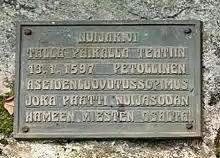Cudgel War
The Cudgel War (also Club War, Finnish: Nuijasota, Swedish: Klubbekriget) was a 1596/97 peasant uprising in Finland (then part of the Kingdom of Sweden). The name of the uprising derives from the fact that the peasants armed themselves with various blunt weapons, such as cudgels, flails, and maces, as they were seen as the most efficient weapons against their heavily armoured enemies. The yeomen also had swords, some firearms, and two cannons at their disposal. Their opponents, the troops of Clas Eriksson Fleming, were professional, heavily armed and armoured men-at-arms.[1]
| Cudgel War | |||||||
|---|---|---|---|---|---|---|---|
| Part of the War against Sigismund | |||||||
 Burned Village (1879) by Albert Edelfelt. | |||||||
| |||||||
| Belligerents | |||||||
| Peasants and army | Nobility and army | ||||||
| Commanders and leaders | |||||||
|
Jaakko Ilkka Pentti Pouttu (POW) Hannu Krankka Yrjö Kontsas Israel Larsson Support: Enemies of Fleming among the nobility |
| ||||||
| Strength | |||||||
| 1,000–4,000+ | 1,500–3,300+ | ||||||
| Casualties and losses | |||||||
|
>2,550 dead >500 P.O.W. | >25 dead | ||||||
| The strength varied in different engagements and from some of them there are approximations | |||||||
Modern Finnish historiography sees the uprising in the context of the conflict between Duke Charles and Sigismund, King of Sweden and Poland (War against Sigismund). Charles agitated the peasants to revolt against the nobility of Finland, who supported Sigismund in the conflict.
War

An uprising began on Christmas Eve 1595 and was initially successful, but shortly thereafter was crushed by cavalry.[2] In December 1596, the Cudgel War began.[3] The peasants won a number of encounters with infantry.[3] Klaus Fleming began negotiating a truce that required the surrender of peasant leader Jaakko Ilkka. Ilkka fled to avoid being handed over and the peasant army scattered, pursued by the soldiers. At least 1500 were killed within the next two months.[3] Along with Ilkka, five other rebellion leaders were executed on January 27, 1597.[4]
Final part of the rebellion

Israel Larsson was named as the new governor of central and northern Ostrobothnia, and planned to support the rebellion. However, he fled rather than face Fleming. Leaderless, the peasants opened battle with Fleming on February 24, 1597. Over 1000 were killed and 500 captured.[3]
The insurgents were mostly Finnish peasants from Ostrobothnia, Northern Tavastia, and Savo. The events can also be seen as a part of a larger power struggle between King Sigismund and Duke Charles.[1][5]
Legacy
In his work Nuijasota, sen syyt ja tapaukset (1857–1859) (English: Club War, its reasons and causes), historian and fennoman Yrjö Koskinen (né Forsman) saw the peasants as fighting for freedom and justice. Fredrika Runeberg's Sigrid Liljeholm (1862), one of the first historical novels in Finland, depicts women's fates during the war. Albert Edelfelt's painting Burned Village (1879) depicts a woman, a child, and an old man hiding behind a rock as a village burns in the background.[6] The poet Kaarlo Kramsu praised the insurgents and lamented their defeat in patriotic poems such as Ilkka, Hannu Krankka, and Santavuoren tappelu, published in Runoelmia (1887). After the Finnish Civil War, the debate has centered on an interpretation that emphasizes Duke Charles's role in inciting the revolt, as found in Pentti Renvall's Kuninkaanmiehiä ja kapinoitsijoita Vaasa-kauden Suomessa (1949); and an explanation that stresses the roots of the rebellion in social injustice and class conflict, as argued by Heikki Ylikangas in Nuijasota (1977). A historical reenactment of the Cudgel War is conducted yearly in the Kavalahti scout camp.[7] Jaakko Ilkka took the 75th place in the Great Finns TV show. A commemorative silver coin was also minted to mark the occasion.[8]
See also
References
Notes
- "Finnish peasant history". Retrieved 13 July 2014.
- "Jaakko Ilkka's Descendants". Retrieved 12 July 2014.
- "Jaakko Ilkka's biography". Archived from the original on 5 June 2016. Retrieved 13 July 2014.
- "Battle Map (Finnish)". Archived from the original on 12 August 2009. Retrieved 12 July 2014.
- "Charles (Finnish)". Retrieved 12 July 2014.
- "Painting". Archived from the original on 13 December 2006. Retrieved 12 July 2014.
- "Cudgel War Reenactment". Archived from the original on 14 July 2014. Retrieved 7 July 2014.
- "Coin". Retrieved 12 July 2014.
